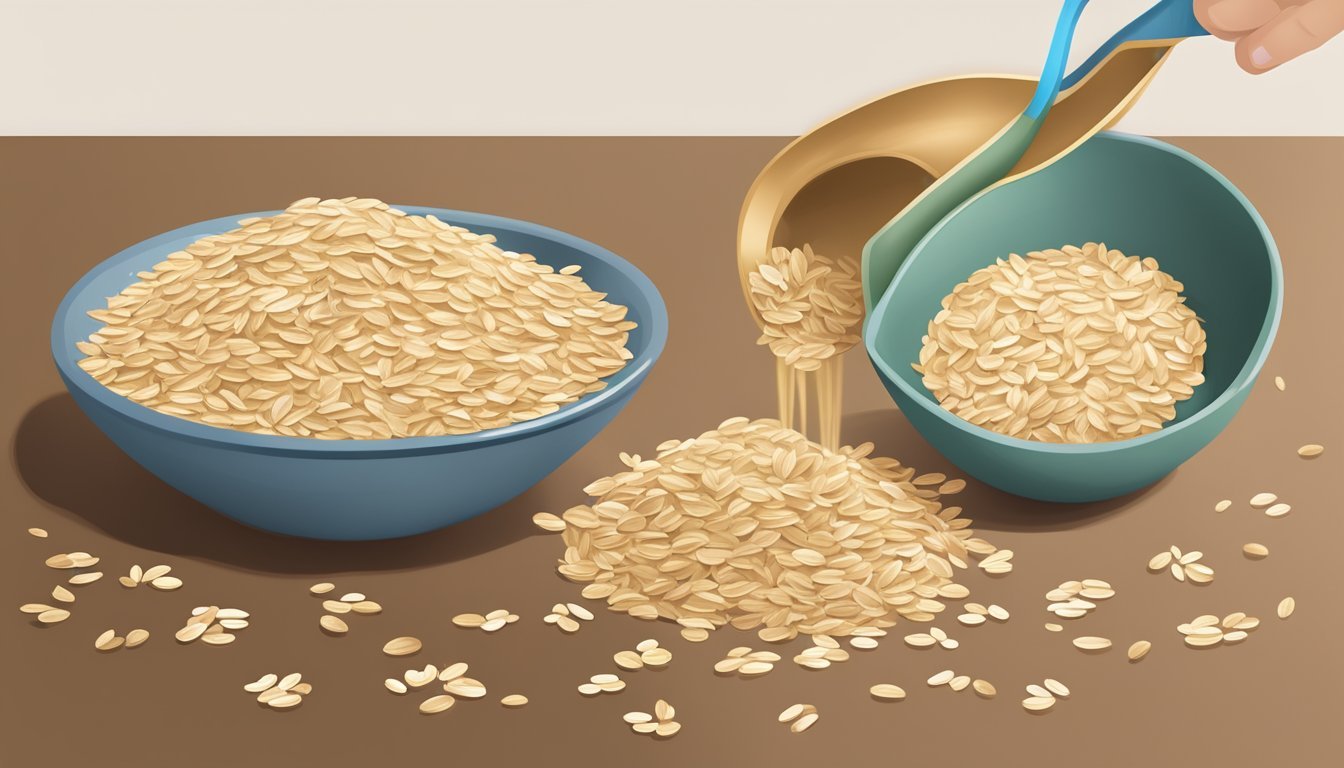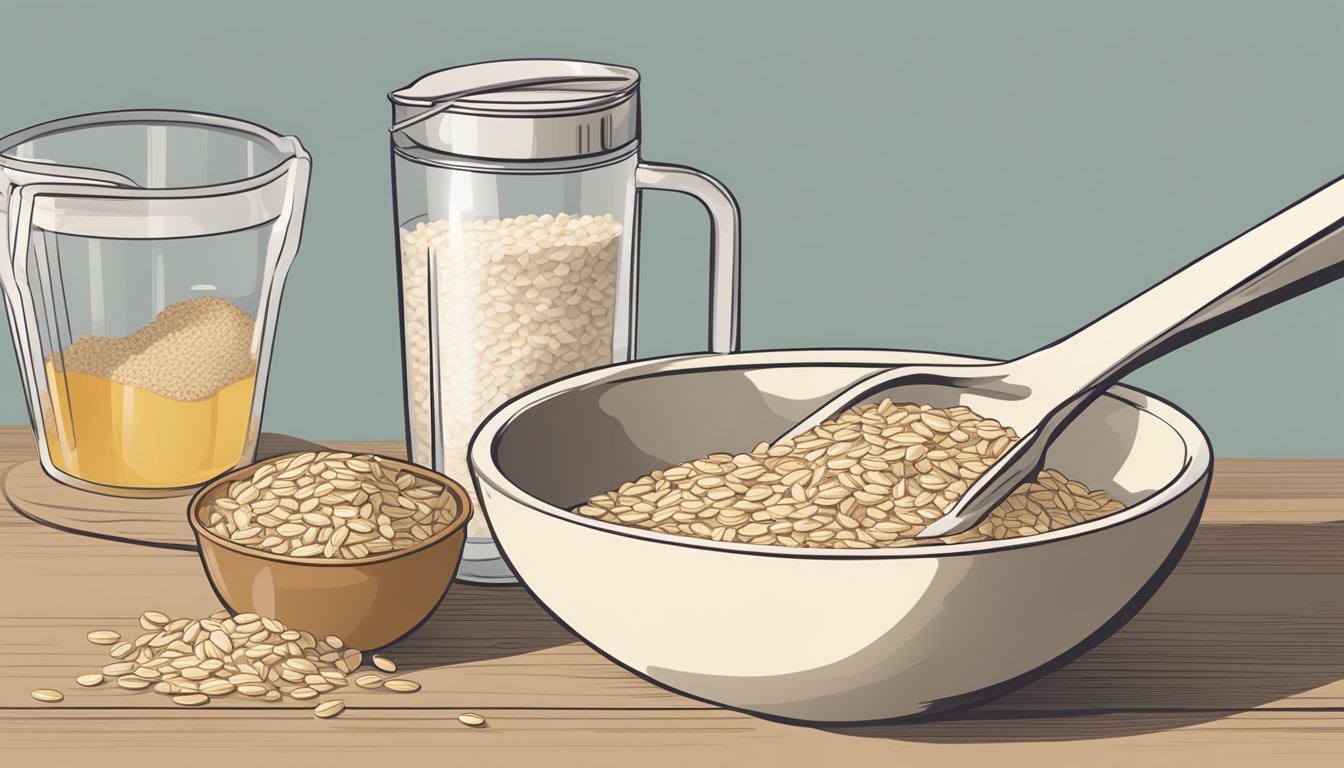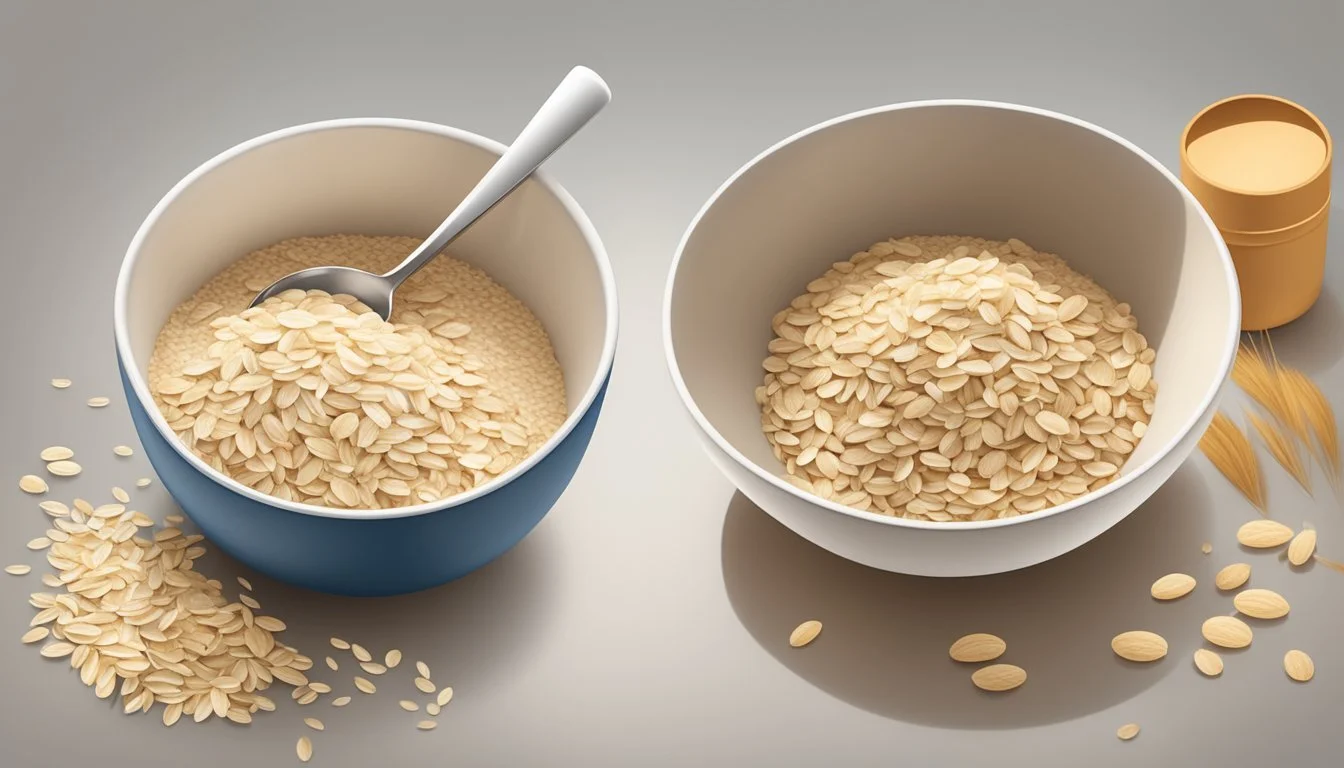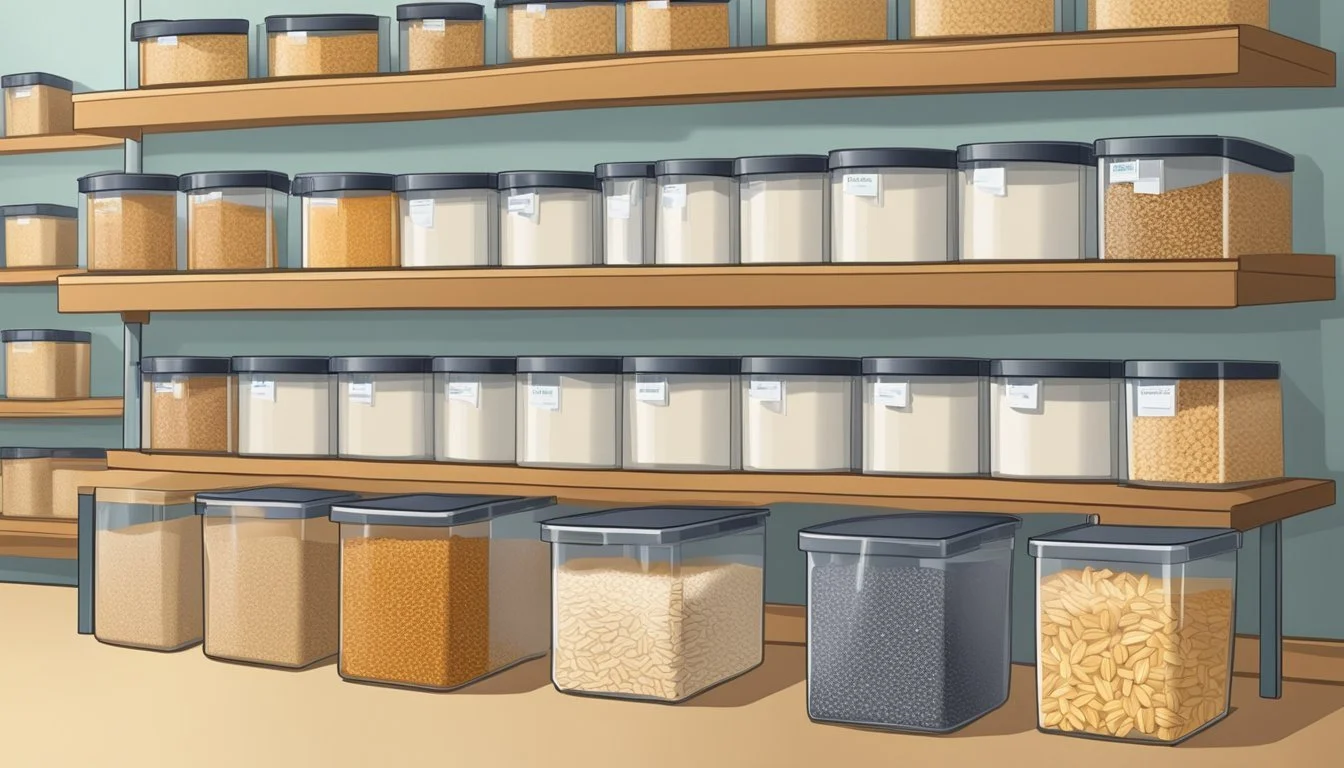How to Substitute Quick Oats for Rolled Oats
A Guide for Easy Baking Swaps
In many recipes, oats serve as a versatile ingredient, renowned for providing a rich source of fiber and giving a distinct, nutty texture to a range of dishes. Quick oats and rolled oats, while both derived from whole oat groats, differ in their processing, size, and cooking times. Quick oats, processed more extensively than rolled oats, are cut finer, steamed longer, and rolled thinner. This makes them cook faster and absorb liquid more readily, leading to a softer texture upon cooking.
When substituting quick oats for rolled oats in a recipe, it's important for one to consider these textural differences. Since quick oats are more broken down than rolled oats, they generally do not provide the same chewiness and structure in recipes like granola bars or cookies. However, they can often be used in equal measure for recipes where the oat texture is not the primary concern, such as in oatmeal or blended into oat flour. In baking, one may substitute quick oats for up to one-third of the flour without significantly altering the recipe's structure.
For those devising hearty breakfasts or baking homemade treats, knowing how to effectively substitute one form of oats for another is invaluable. While each type of oat brings its own attributes to the table, they can typically be interchanged with some adjustments. This offers flexibility to home cooks and bakers, ensuring that the lack of a specific type of oat doesn't hinder the creation of a delectable dish.
Understanding Oats
When exploring the different uses of oats in cooking and baking, it's essential to understand the various types available, their nutritional content, and how they contribute to health benefits.
Types of Oats
Oats come in various forms, each processed to different degrees. The main types include:
Steel-cut oats: These are the least processed form, simply chopped into pieces. They have a chewy texture and require longer cooking times.
Rolled oats (old-fashioned oats): Oats that are steamed and rolled flat. They cook faster than steel-cut oats while retaining a similar nutty flavor.
Quick oats: More finely cut than rolled oats and steamed longer, they cook more rapidly due to their smaller size.
Instant oats: The most processed form, precooked and dried before being rolled. They cook the quickest and can become mushy.
Nutritional Value
Oats, regardless of type, are a rich source of nutrients, offering a balanced profile of vitamins, minerals, and healthy fats. A comparison of their nutritional content highlights:
Nutrient Steel-cut Oats Rolled Oats Quick Oats Instant Oats Calories Comparable Comparable Comparable Comparable Protein Content High High High Moderate Fiber Content High High Moderate Lower B Vitamins Good amount Good amount Good amount Good amount Iron & Magnesium Rich source Rich source Rich source Rich source Antioxidants Present Present Present Present
Oats and Health Benefits
Oats are celebrated for their health benefits. They are considered whole grains and provide several health advantages such as the ability to lower cholesterol levels, thanks to the soluble fiber known as beta-glucan. This fiber also aids in weight loss and blood sugar regulation by promoting a feeling of fullness and slowing digestion. The nutrients found in oats like iron, magnesium, phosphorus, potassium, as well as B vitamins, contribute to overall health. Oats are also associated with a reduced risk of heart disease due to their content of healthy fats and antioxidants.
Basics of Oat Substitution
In the context of oat substitution, it is crucial to recognize that while quick oats and rolled oats can exchange places in a recipe, attention to ratios, texture, and flavor is essential to maintain the intended outcome of the dish.
When to Substitute
Substituting quick oats for rolled oats is suitable when one is pressed for time, as quick oats cook faster due to their smaller size and thinner cut. They can be used in a majority of recipes that call for rolled oats, including baking and making porridge.
Determining Ratios
The rule of thumb for replacing rolled oats with quick oats is a 1:1 ratio. This straightforward substitution works because the oats are essentially the same product in different forms. However, the liquid content of the recipe may need slight adjustments as quick oats tend to absorb liquid more quickly.
Textural Considerations
The texture is an unmistakable difference with quick oats providing a softer and less pronounced texture compared to rolled oats. If one desires to mimic the texture of rolled oats, using a food processor to coarsely chop the oats might be a consideration. Baked goods will tend to have a finer, denser structure when using quick oats.
Flavor Adjustments
Flavor is not significantly affected by the substitution since quick oats and rolled oats have a similar taste profile. Nevertheless, one may need to tweak additional flavoring elements or fiber additions as quick oats could alter the balance of tastes and texture in a recipe.
Cooking and Baking With Oats
Cooking and baking with oats require attention to specific details, such as liquid content, cooking time, and temperature, to achieve the desired texture and flavor in dishes ranging from breakfast oats to desserts.
Adjusting Liquid Content
When substituting quick oats for rolled oats in recipes, it may be necessary to alter the amount of liquid ingredients. Quick oats absorb liquid at a different rate than rolled oats. For instance, in oatmeal cookies and no-bake recipes, an increase in liquid by approximately 1/4 cup may be needed to compensate for the quick oats' absorption.
Cooking Time Variance
Cooking time for quick oats is significantly less than for rolled oats. In stovetop cooking, where rolled oats may take up to 15 minutes, quick oats cook in as little as one minute. For microwave cooking, the time is reduced from 5-10 minutes for rolled oats to about 30 seconds for quick oats.
Oven Temperature Changes
Baked goods such as cookies made with quick oats instead of rolled oats may require adjustments to oven temperature. However, most recipes are tolerant of the substitution without the need for temperature adjustments. It's more crucial to monitor the baking time, as quick oats can cook faster and may lead to a slightly different texture.
Baking with Oat Flour
Substituting oats with oat flour offers a finer consistency ideal for baked goods that benefit from a smoother texture. Oat flour can provide a high fiber alternative in recipes, yet may alter the sweetening, thickening, and leavening properties of a dish. When using oat flour, bakers may need to experiment with the amount and consider additional binding agents like eggs to compensate for the lack of gluten.
Alternative Oat Options
When substituting quick oats for rolled oats, one can consider various alternatives based on dietary needs and recipe requirements. These alternatives include gluten-free options and substitutes for baked goods, as well as non-oat alternatives that provide different nutritional benefits.
Gluten-Free Alternatives
For individuals with celiac disease or a sensitivity to gluten, it's crucial to avoid cross-contamination with gluten-containing grains. Gluten-free alternatives include:
Quinoa Flakes: A protein-rich option that mimics the texture of rolled oats.
Rice Flakes: Offer a similar consistency to rolled oats and are suitable for those avoiding gluten.
Buckwheat Groats: Despite the name, they are gluten-free and closely resemble the texture of traditional oats.
Substitutes for Baked Goods
In baking, substitutes must maintain the desired texture and consistency of the final product. Suitable substitutes for rolled oats in baked goods are:
Steel-Cut Oats: Provide a robust texture suitable for durable recipes like baked oatmeal.
Almond Meal: Adds moisture and a nutty flavor, which can be beneficial in certain pastries and cookies.
Non-Oat Alternatives
For those looking to diversify their diet beyond oats, various grains and seeds offer nutritional value. Some of these options include:
Amaranth: Offers a rich source of iron, magnesium, and B vitamins.
Millet: A versatile grain that is rich in nutrients.
Seeds: Chia seeds and flaxseeds can be used as alternatives due to their high fiber content and ability to mimic the binding properties of oats in recipes.
Creative Oatmeal Ideas
Oatmeal's versatility allows for an array of gourmet interpretations, from savory delights that capitalize on its nutty flavor and fiber content to sweet concoctions that transform it into an indulgent treat. Its creamy texture serves as an excellent canvas for both robust and delicate flavor pairings.
Savory Oatmeal Dishes
One can transform the traditional porridge into a savory meal by adding ingredients that contribute umami and depth.
Cheese and Herb Oatmeal: Stirring in grated cheese and fresh herbs like thyme or rosemary into cooked oatmeal can create a comforting, risotto-like dish.
Asian-Inspired Oat Porridge: Incorporating soy sauce, scallions, a soft-boiled egg, and sesame seeds will give the oatmeal a savory Asian twist.
Sweet Oatmeal Creations
Sweet oatmeal dishes often incorporate sweeteners and flavorful mix-ins for a delightful start to the day.
Fruit and Spice Oatmeal: Adding sliced apples, cinnamon, and a touch of maple syrup can enliven a bowl of morning oats.
Chocolate and Nut Oatmeal: Swirling in cocoa powder and topping with nuts and a drizzle of honey brings a dessert-like quality to the breakfast staple.
Overnight Oats
Overnight oats offer a no-cook, convenient option that melds flavor and texture as it sets, resulting in a mushy, yet desirable consistency.
Classic Overnight Oats: Mixing quick oats with milk or a dairy-free alternative, a spoonful of yogurt, and chia seeds, then leaving it to soak overnight, creates a creamy and protein-rich breakfast.
Tropical Overnight Oats: Incorporating coconut milk, diced mango, and a squeeze of lime juice can transform the base into a tropical treat.
Health and Dietary Considerations
When considering the substitution of quick oats for rolled oats, it's important to understand the health and dietary impacts this change could have. Key factors include the effects on weight loss, heart health, and overall dietary adjustments.
Oats for Weight Loss
Quick oats and rolled oats differ in their glycemic index (GI) due to processing differences. Rolled oats have a lower GI, meaning they digest more slowly, leading to more consistent blood sugar levels and potentially aiding in weight management. Substituting with quick oats, which have a higher GI, may lead to quicker digestion and shorter satiety periods.
Oats for Heart Health
Both quick oats and rolled oats contribute to heart health by supplying healthy cholesterol levels. They contain dietary fiber, particularly beta-glucan, which is known for lowering cholesterol. Despite the difference in texture and cooking time, the heart-healthy benefits of soluble fiber are retained in both forms.
Dietary Adjustments for Oats
For individuals following a specific diet, such as a vegan diet, both quick and rolled oats remain suitable as they are plant-based sources of protein and healthy fats. Rolled oats can offer slightly more dietary fiber per serving, which is an essential component in vegan diets for maintaining digestive health. The nutritional value in terms of vitamins and minerals is comparable in both forms, ensuring that one can substitute quick oats without significant dietary compromises.
Preparation Techniques
When substituting quick oats for rolled oats, it's important to recognize that cooking times and methods will differ. Quick oats cook faster due to their smaller size, thus altering the cooking time is crucial to achieving the desired texture.
Stovetop Cooking
On the stovetop, quick oats can be cooked by combining them with water or milk. For every one cup of quick oats, one should typically use two cups of liquid. Bring the mixture to a boil, then reduce the heat to a simmer, stirring occasionally. The oats should be ready in about 1-2 minutes. Since they cook more quickly than rolled oats, they require less time on the heat and should be watched closely to prevent overcooking.
Microwave Cooking
For those preferring the convenience of a microwave, quick oats offer an expedient option. Mix one cup of quick oats with two cups of water or milk in a microwave-safe bowl. Cook on high for 1-1.5 minutes, stirring halfway through. Microwaves vary in power, so the first batch might require some trial and error to perfect the timing.
Using Oats as Thickeners
Quick oats, due to their finely cut texture and high fiber content, can be an effective thickener in recipes. They absorb liquid easily, which can be harnessed to thicken soups, stews, or as a binding agent in recipes like meatloaf or veggie burgers. Add the quick oats directly to the dish and allow them to cook for a short duration, as they will thicken the mixture faster than rolled oats.
Storing and Shelf Life
When substituting quick oats for rolled oats, it's crucial to consider the differences in their shelf life and storage methods. Quick oats, also known as instant oats, have a finer texture and are designed to cook more rapidly due to their increased surface area. On the other hand, rolled oats, which are thicker and have a chewier texture, typically maintain their nutty flavor and structural integrity over a longer period.
Quick oats should be stored in a cool, dry place and, ideally, in an airtight container to retain freshness. They generally last between 6 to 9 months.
In contrast, rolled oats have a longer shelf life, ranging from 1 to 2 years under similar storage conditions.
Both types of oats should be kept away from strong odors and moisture to prevent them from absorbing unwanted flavors or becoming spoiled.
Oat Type Shelf Life Storage Tips Quick Oats 6 - 9 months Airtight container; cool, dry place Rolled Oats 1 - 2 years Airtight container; cool, dry place
For those who use oat flour, this ground form of oats should also be stored in an airtight container. Its shelf life is comparable to that of quick oats, due to its fine texture that can absorb moisture and odors more easily.
By understanding these nuances, one can ensure that oats maintain their optimal flavor and texture, making them a versatile ingredient for a variety of recipes.








